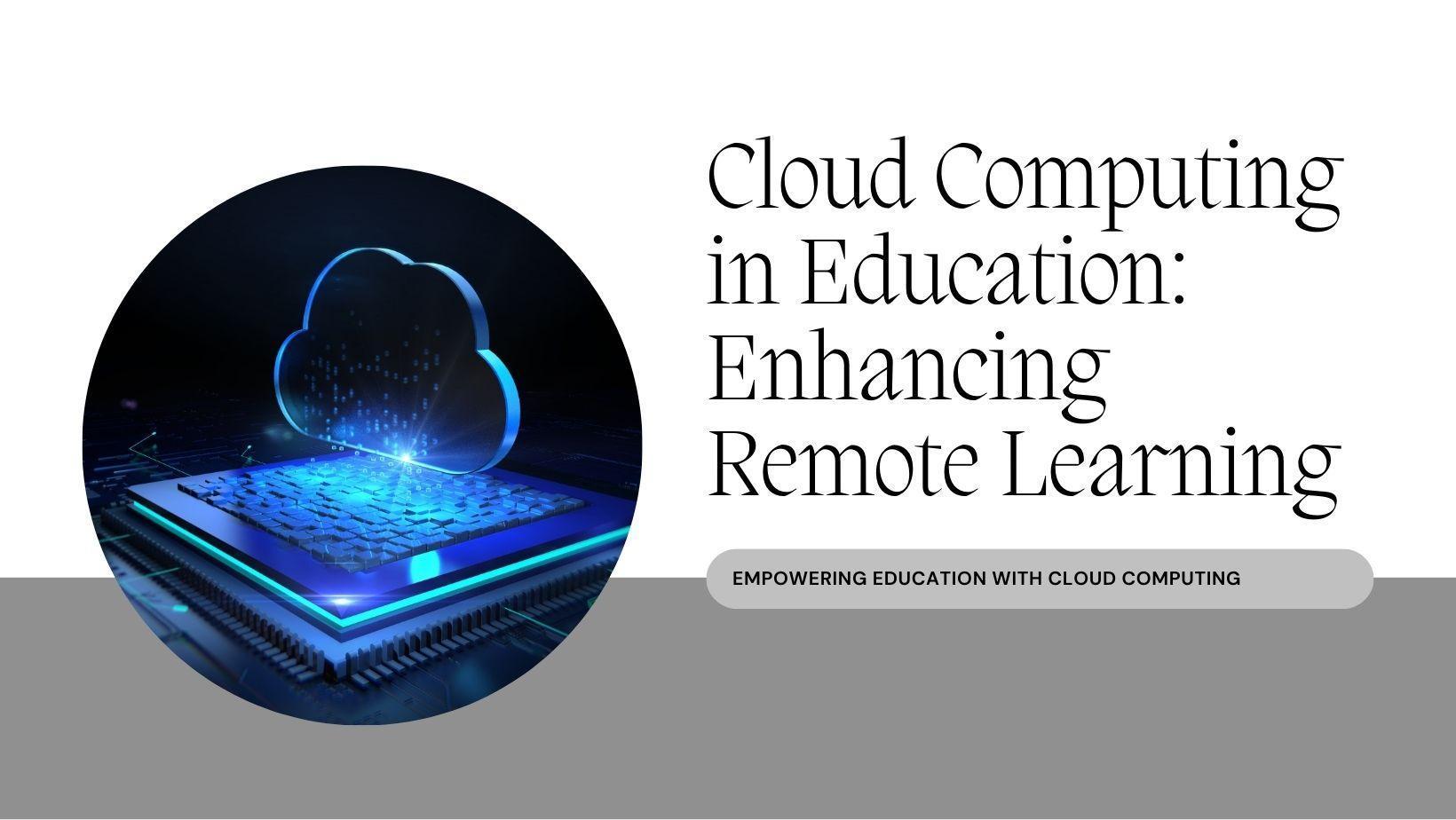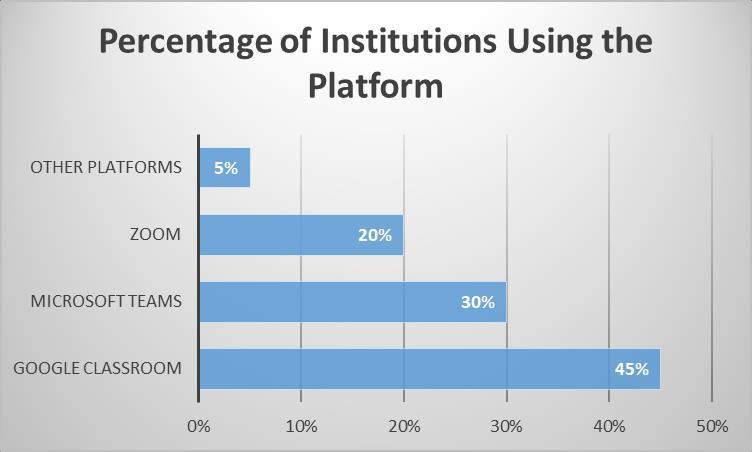
International Research Journal of Engineering and Technology (IRJET) e-ISSN:2395-0056
Volume: 11 Issue: 07 | July 2024 www.irjet.net p-ISSN:2395-0072


International Research Journal of Engineering and Technology (IRJET) e-ISSN:2395-0056
Volume: 11 Issue: 07 | July 2024 www.irjet.net p-ISSN:2395-0072
Venukumar Chirlawar
Amazon, USA

Abstract
The rapid adoption of cloud solutions has transformed remote learning, offering unprecedented opportunities for educational institutions to deliver high-quality education during challenging times. This article explores the key benefits andapplicationsofcloud-basedplatformsandtoolsinenablingseamlessaccesstoeducationalresources,facilitatingrealtime communication and collaboration, providing scalable infrastructure, and supporting personalized learning experiences. The real-world impact of cloud solutions is discussed, emphasizing their role in increasing accessibility to education, enhancing learning experiences through interactive and personalized approaches, and ensuring operational continuityduringdisruptionssuchastheCOVID-19pandemic.However,thearticlealsohighlightscriticalchallengesand considerationsthatmustbeaddressedtofullyrealizethepotentialofcloud-basedremotelearning.Theseincludebridging the digital divide to ensure equal access to technology, prioritizing data privacy and security concerns, and providing adequate training and support for teachers to effectively utilize cloud technologies in remote instruction. By addressing thesechallengesandleveragingthebenefitsofcloudsolutions,educationalinstitutionscancreateinclusive,engaging,and resilientremotelearningenvironmentsthatcatertothediverseneedsofstudentsinanincreasinglydigitalworld.
Keywords: Cloud computing in education, Remote learning, personalized learning, Digital divide, Data privacy and security
Therapidadvancementoftechnologyhasrevolutionizedvarioussectors,andeducationisnoexception.Cloudcomputing, in particular, has emerged as a game-changer in the educational landscape, offering a myriad of benefits such as costeffectiveness,scalability,andflexibility[1].Theadoptionofcloudcomputingineducationhasbeensteadilygrowing,with institutionsleveragingcloud-basedplatformsandservicestoenhanceteaching,learning,andadministrativeprocesses[2].

International Research Journal of Engineering and Technology (IRJET) e-ISSN:2395-0056
Volume: 11 Issue: 07 | July 2024 www.irjet.net p-ISSN:2395-0072
However, the true potential of cloud computing in education was put to the test during the unprecedented COVID-19 pandemic. As educational institutions worldwide were forced to close their physical doors and transition to remote learningalmostovernight,traditionalITinfrastructurestruggledtokeeppacewiththesuddensurgeindemandforonline resources and collaboration tools [3]. It was in this context that cloud computing emerged as a lifeline, enabling educational institutions to continue delivering education remotely and ensuring operational continuity in the face of adversity.
ThisarticleexploresthecrucialroleplayedbycloudcomputingineducationduringtheCOVID-19pandemic,focusingon how it enhanced remote learning capabilities and helped educational institutions navigate the challenges posed by the sudden shift to online education. By examining specific applications, real-world examples, and the impact of cloud computing on accessibility, learning experiences, and administrative efficiency, this article seeks to highlight the transformativepowerofcloudtechnologyinensuringeducationalresilienceandinnovationintimesofcrisis.
A.Cloud-basedplatformsandtools
Cloud-basedplatformsandtoolshaverevolutionizedremotelearningbyprovidingeducatorsandstudentswithseamless access to a wide range of educational resources. Three prominent examples of such platforms are Google Classroom, Microsoft Teams, and Zoom [4]. Google Classroom offers a comprehensive suite of tools for creating, distributing, and grading assignments, while Microsoft Teams provides a collaborative workspace for virtual classes and meetings [5]. Zoom,ontheotherhand,hasbecomeapopularchoiceforvideoconferencing,enablingreal-timecommunicationbetween teachersandstudents[6].
B.Keybenefitsandapplications
Seamless access to educational resources
Cloud-based Learning Management Systems (LMS) have transformed the way educational resources are accessed and distributed.Thesesystemsalloweducatorstodigitallydistributetextbooks,assignments,andotherlearningmaterialsto students, eliminating the need for physical copies [7]. For example, many schools have adopted digital textbook distribution through cloud-based platforms, ensuring that students have instant access to the latest educational content [8].
Real-time communication and collaboration
Videoconferencingandcollaborationtoolshavebecomeessentialforremotelearning,enablingreal-timecommunication between teachers and students. Live lectures and virtual office hours can be conducted through platforms like Zoom, Google Meet, and Microsoft Teams [9]. These tools foster interactive learning experiences and provide students with the opportunitytoengagewiththeirteachersandpeersinreal-time[10].
Scalable infrastructure
The flexibility and scalability of cloud services have made it possible to support large-scale virtual classes. Cloud infrastructurecaneasilyaccommodatethevaryingdemandsofremotelearning,allowingeducationalinstitutionstoscale theirresourcesasneeded[11].Forinstance,universitiescanleveragecloudservicestohostvirtualclasseswithhundreds ofstudents,ensuringaseamlesslearningexperience[12].
Personalized learning and support
Adaptive learning platforms, powered by artificial intelligence (AI), have the potential to revolutionize personalized learninginremotesettings.Theseplatformscananalyzestudentperformancedataandprovidecustomizedlearningpaths tailored to individual needs [13]. AI-powered tutoring systems can offer targeted support to students, helping them overcomelearningchallengesandachievetheiracademicgoals[14].

International
Volume: 11 Issue: 07 | July 2024 www.irjet.net











1:Impactofcloud-basedremotelearningonstudentperformance[12,13,14]
Administrative efficiency
Cloud solutions have streamlined administrative operations in educational institutions. Cloud-based student information systems (SIS) have simplified tasks such as enrollment, attendance tracking, and grade management [15]. By leveraging cloudtechnology,schoolscanreducepaperwork,automateprocesses,andimproveoverallefficiencyinmanagingstudent recordsandadministrativetasks[16].
Benefit Application Example
Seamless access to educational resources Cloud-based Learning Management Systems(LMS)
Real-time communication and collaboration Video conferencing and collaborationtools
Scalableinfrastructure
Digital textbook and assignment distribution
Live lectures and virtual office hours
Flexibility and scalability of cloud services Supporting large-scale virtual classes
Personalized learning and support Adaptivelearningplatforms
AI-powered tutoring and customizedlearningpaths
Table1:Benefitsandapplicationsofcloudsolutionsinremotelearning[5,7,9,10]
A.Increasedaccessibilitytoeducationalresources
The widespread adoption of cloudsolutionshasrevolutionizedaccessto educational resources, particularlyforstudents in remote or underserved areas. A study [17] highlights the opportunities and challenges of using cloud computing in Malaysianhighereducationinstitutions,emphasizinghowcloud-basedplatformscanbridgethedigitaldivideandprovide equal access to learning materials. Students can now access a wide range of educational content, participate in virtual classes, and collaborate with their peers, regardless of their geographical location [18]. This increased accessibility has been instrumental in narrowing the educational gap and ensuring that all students have the opportunity to receive a qualityeducation,eveninthefaceofsocioeconomicdisparities.Byleveragingthepowerofcloudcomputing,educational institutionscandistributeresourcesmoreefficientlyandcost-effectively,makingeducationmoreinclusiveand equitable [17,18].

International Research Journal of Engineering and Technology (IRJET) e-ISSN:2395-0056
Volume: 11 Issue: 07 | July 2024 www.irjet.net p-ISSN:2395-0072
B.Enhancedlearningexperiencethroughinteractiveandpersonalizedapproaches
Cloud-based tools have transformed the learning experience by enabling interactive and personalized approaches to education. A study [19] discusses how cloud computing, when combined with mobile learning, can enhance the educational experience by providing students with access to interactive content, virtual whiteboards, and collaborative document editing features. These tools foster active participation and engagement among students, creating a more dynamic and immersive learning environment [19]. Furthermore, personalized learning platforms, powered by cloud technology, can adapt to individual learning styles and paces, providing tailored support and feedback to each student [20]. A study [20] explores how cloud computing can be leveraged to create adaptive learning systems that cater to the unique needs of each learner, ultimately improving learning outcomes and student satisfaction. By harnessing the potentialofcloud-basedpersonalizedlearning,educationalinstitutionscanensurethateverystudentreceivesthesupport andguidancetheyneedtosucceedacademically[19,20].
C.Operationalcontinuityduringunprecedenteddisruptions
The adoption of cloud solutions has proven crucial in maintaining operational continuity during unprecedented disruptions,suchastheCOVID-19pandemic.Whenphysicalclassroomsbecameinaccessibleduetolockdownsandsocial distancingmeasures,educationalinstitutionsquicklytransitionedtoremotelearningusingcloud-basedplatforms[21].As study[21]discusseshowcloudtechnologyhasbeenoptimizedtosupportonlinelearningduringthepandemic, enabling schools and universities to continue delivering education without significant interruptions. This shift to cloud-based remote learning has allowed students to continue their academic progress, despite the challenges posed by the global health crisis [21, 22]. A study [22] presents a new mobile learning model in the context of the COVID-19 pandemic, highlighting how cloud computing has facilitated the rapid adaptation of educational institutions to the new reality of remotelearning.Theresilienceandflexibilityprovidedbycloudsolutionshavebeenessentialinensuringthecontinuityof education during these challenging times, demonstrating the critical role of technology in maintaining academic operations[21,22].

A.Digitaldivideandensuringequalaccesstotechnology
One of the major challenges in implementing cloud solutions for remote learning is the digital divide. UNESCO [23] highlights that not all students have equal access to technology, reliable internet connectivity, or suitable devices for online learning. This disparity in access to digital resources can significantly impact the effectiveness of remote learning

International Research Journal of Engineering and Technology (IRJET) e-ISSN:2395-0056
Volume: 11 Issue: 07 | July 2024 www.irjet.net p-ISSN:2395-0072
initiatives and exacerbate existing educational inequalities [23]. To address this issue, educational institutions must provide resources, such as device lending programs and internet subsidies, to ensure that all students can participate in remotelearning[24].Thestudy.[24]emphasizetheimportanceofpreparingstudentsforlifeinadigitalageandsuggest thatschoolsandgovernmentsshouldworktogethertobridgethedigitaldividebyprovidingthenecessaryinfrastructure and support for students from diverse socioeconomic backgrounds. By ensuring equal access to technology, educational institutionscancreateamoreinclusiveandequitableremotelearningenvironment[23,24].
With the increased use of cloud platforms for remote learning, data privacy and security concerns have come to the forefront. Educational institutions must prioritize the protection of student data and ensure compliance with relevant regulations, such as the Family Educational Rights and Privacy Act (FERPA) and the General Data Protection Regulation (GDPR) [25]. The study [25] discusses the challenges faced by cloud providers and users in adhering to the stringent requirements of the GDPR, emphasizing the need for robust data protection measures in the education sector. To safeguard sensitive information, educational institutions should implement strong security measures, including encryption, access controls, and regular security audits [26]. The study [26] provides an overview of network virtualizationtechniquesthatcanbeemployedtoenhancethesecurityandprivacyofcloud-basedsystems,suchasthose usedinremotelearning.Byprioritizingdataprivacyandsecurity,educationalinstitutionscanfostertrustamongstudents and parents, ensuring the confidentiality and integrity of personal information in the virtual learning environment [25, 26].
The transition to remote learning using cloud solutions requires adequate training and support for teachers. Many educators may not be familiar with the various cloud-based tools and platforms, necessitating professional development opportunities[27].Thestudy27]exploresteachers'perceptionsofweb-basedlearningtoolsandhighlightstheimportance of providing training and support to ensure the effective integration of technology in the classroom. Schools and universities must invest in teacher training programs to ensure that educators can effectively utilize cloud technologies and deliver high-quality remote instruction [28]. The study [28] discusses the lessons learned from the COVID-19 pandemic, emphasizing the need for teachers to be trained in emergency remote teaching to maintain the quality of education during disruptions. By equipping teachers with the necessary skills and knowledge to navigate cloud-based remotelearningplatforms,educationalinstitutionscanenhancetheoveralleffectivenessofonlineeducationandensurea smoothtransitiontovirtualclassrooms[27,28].
Challenge Description
Digitaldivide Unequal access to technology, internet connectivity,andsuitabledevices
Data privacy and security Protecting student data and ensuring compliance with regulations (e.g., FERPA, GDPR)
Teacher training andsupport Educators' unfamiliarity with cloud-based toolsandplatforms
Mitigation Strategies
Provide device lending programs and internetsubsidies
Implementencryption,accesscontrols, andregularsecurityaudits
Invest in professional development opportunitiesandtrainingprograms
Table2:Challengesandconsiderationsinimplementingcloudsolutionsforremotelearning[23-28]
V. Conclusion
In conclusion, cloud solutions have played a vital role in enabling remote learning during unprecedented times. Cloudbased platforms and tools have provided seamless access to educational resources, facilitated real-time communication and collaboration, and offered personalized learning experiences. The adoption of cloud solutions has increased accessibility to education, enhanced the learning experience, and ensured operational continuity. However, challenges suchasthedigital divide,data privacyconcerns, and theneedfor teachertraining mustbeaddressedtofullyrealizethe potential of cloud-based remote learning. As educational institutions continue to navigate the evolving landscape of education, cloud solutions will undoubtedly remain a crucial component in delivering effective and inclusive remote learningexperiences.

International Research Journal of Engineering and Technology (IRJET) e-ISSN:2395-0056
Volume: 11 Issue: 07 | July 2024 www.irjet.net p-ISSN:2395-0072
References:
[1] M. Almajalid, "A Survey on the Adoption of Cloud Computing in Education Sector," arXiv preprint arXiv:1706.01136, 2017.
[2] S. Ding, C. Xiong, and L. Liu, "A Survey on Cloud Computing in Education," in 2015 International Conference on ComputationalScienceandComputationalIntelligence(CSCI),2015,pp.1061-1066.
[3] R. Raman et al., "Adoption of Cloud Computing in Education System: A Survey," International Journal of Advanced ScienceandTechnology,vol.29,no.6,pp.3556-3564,2020.
[4]G.BasilaiaandD.Kvavadze,"TransitiontoOnlineEducationinSchoolsduringaSARS-CoV-2Coronavirus(COVID-19) PandemicinGeorgia,"PedagogicalResearch,vol.5,no.4,pp.1-9,2020,doi:10.29333/pr/7937.
[5] M. Pokhrel and C. Choi, "A Review on Cloud-Based Learning and Collaboration Tools for Online Education," in IEEE Access,vol.9,pp.98847-98866,2021,doi:10.1109/ACCESS.2021.3095188.
[6]C.Rapanta,L.Botturi,P.Goodyear,L.Guàrdia,andM.Koole,"OnlineUniversityTeachingDuringandAftertheCovid-19 Crisis: Refocusing Teacher Presence and Learning Activity," Postdigital Science and Education, vol. 2, no. 3, pp. 923-945, 2020,doi:10.1007/s42438-020-00155-y.
[7] N. Selviandro and M. Hasibuan, "Cloud-Based E-Learning: A Proposed Model and Benefits by Using E-Learning Based on Cloud Computing for Educational Institution," in Information and Communication Technology, ser. Lecture Notes in Computer Science, K. Mustofa et al., Eds. Berlin, Heidelberg: Springer, 2013, vol. 7804, pp. 192-201, doi: 10.1007/978-3642-36818-9_20.
[8]J.Qasem,R.Shehab,andA.Ashaer,"CloudBasedE-LearningApproaches:ASurvey,"in2019InternationalConference onFourthIndustrialRevolution(ICFIR),2019,pp.1-7,doi:10.1109/ICFIR.2019.8894719.
[9] D. Sandhu and N. Sood, "Cloud-Based Education as a Service (EaaS) Model for Enhancing the Quality of Education in Developing Countries," in 2015 Fifth International Conference on Advanced Computing & Communication Technologies, 2015,pp.389-394,doi:10.1109/ACCT.2015.86
[10] S. Stein, J. Ware, J. Laboy, and H. E. Schaffer, "Improving K-12 Pedagogy via a Cloud Designed for Education," InternationalJournalofInformationManagement,vol.33,no.1,pp.235-241,2013,doi:10.1016/j.ijinfomgt.2012.07.009.
[11]S.Ouf,M.Nasr,andY.Helmy,"AnEnhancedE-LearningEcosystemBasedonanIntegrationbetweenCloudComputing andWeb2.0,"in2010IEEEInternationalSymposiumonSignalProcessingandInformationTechnology(ISSPIT),2010,pp. 48-55,doi:10.1109/ISSPIT.2010.5711721.
[12]A.Fernández,D.Peralta,J.M.Benítez,andF.Herrera,"E-LearningandEducationalDataMininginCloudComputing: AnOverview,"InternationalJournalofLearningTechnology,vol.9,no.1,pp.25-52,2014,doi:10.1504/IJLT.2014.062447.
[13] K. Colchester, H. Hagras, D. Alghazzawi, and G. Aldabbagh, "A Survey of Artificial Intelligence Techniques Employed for Adaptive Educational Systems within E-Learning Platforms," Journal of Artificial Intelligence and Soft Computing Research,vol.7,no.1,pp.47-64,2017,doi:10.1515/jaiscr-2017-0004.
[14] R. Luckin, W. Holmes, M. Griffiths, and L. B. Forcier, "Intelligence Unleashed: An Argument for AI in Education," PearsonEducation,2016.
[15]N.Sultan,"CloudComputingforEducation:ANewDawn?"InternationalJournalofInformationManagement,vol.30, no.2,pp.109-116,2010,doi:10.1016/j.ijinfomgt.2009.09.004.
[16]L.Chandra andD.Malaya,"RoleofCloudComputinginEducation,"in2012International ConferenceonComputing, ElectronicsandElectricalTechnologies(ICCEET),2012,pp.832-836,doi:10.1109/ICCEET.2012.6203884.
[17] A. Shahzad, A. G. Golamdin, and N. A. Ismail, "Opportunity and Challenges Using the Cloud Computing in the Case of Malaysian Higher Education Institutions," in 2014 International Conference on Computer and Information Sciences (ICCOINS),2014,pp.1-5,doi:10.1109/ICCOINS.2014.6868451.
© 2024, IRJET | Impact Factor value: 8.226 | ISO 9001:2008 Certified Journal | Page551

International Research Journal of Engineering and Technology (IRJET) e-ISSN:2395-0056
Volume: 11 Issue: 07 | July 2024 www.irjet.net p-ISSN:2395-0072
[18]S.AlamandM.M.Noor,"ICTAdoptioninSmallandMediumEnterprises:AnEmpiricalEvidenceofServiceSectorsin Malaysia," International Journal of Business and Management, vol. 4, no. 2, pp. 112-125, 2009, doi: 10.5539/ijbm.v4n2p112.
[19] N. M. Rao, C. Sasidhar, and V. S. Kumar, "Cloud Computing Through Mobile-Learning," International Journal of AdvancedComputerScienceandApplications,vol.1,no.6,pp.42-47,2010,doi:10.14569/IJACSA.2010.010607.
[20] H. Pardeshi, "Cloud Computing for Higher Education Institutes: Architecture, Strategy and Recommendations for EffectiveAdaptation,"ProcediaEconomicsandFinance,vol.11,pp.589-599,2014,doi:10.1016/S2212-5671(14)00224-X.
[21] A. Sari, A. Rahayu, and M. Apriyani, "Optimization Online Learning Based on Cloud Technology in Education 4.0," in JournalofPhysics:ConferenceSeries,vol.1764,no.1,p.012131,2021,doi:10.1088/1742-6596/1764/1/012131.
[22] A. Al-Hunaiyyan, S. Al-Sharhan, and R. Alhajri, "A New Mobile Learning Model in the Context of the COVID-19 Pandemic," International Journal of Interactive Mobile Technologies (iJIM), vol. 14, no. 7, pp. 4-20, 2020, doi: 10.3991/ijim.v14i07.13787.
[23] UNESCO, "Education: From Disruption to Recovery," 2020. [Online]. Available: https://en.unesco.org/covid19/educationresponse
[24]J.Fraillon,J.Ainley,W.Schulz,T.Friedman,andE.Gebhardt,"PreparingforLifeinaDigitalAge:TheIEAInternational Computer and Information Literacy Study International Report," Springer International Publishing, 2014, doi: 10.1007/978-3-319-14222-7.
[25]D.Dittert,D.Härting,andA.Reichstein,"GeneralDataProtectionRegulation(GDPR)-ChallengesforCloudProviders and Cloud Users," in CLOUD COMPUTING 2018: The Ninth International Conference on Cloud Computing, GRIDs, and Virtualization,2018,pp.72-75.
[26]N.ChowdhuryandS.Boutaba,"ASurveyofNetworkVirtualization,"ComputerNetworks,vol.54,no.5,pp.862-876, 2010,doi:10.1016/j.comnet.2009.10.017.
[27]R.Kay,T.Knaack,andD.Petrarca,"ExploringTeachers'PerceptionsofWeb-BasedLearningTools,"Interdisciplinary JournalofE-LearningandLearningObjects,vol.5,no.1,pp.27-50,2009,doi:10.28945/68.
[28] T. Trust and J. Whalen, "Should Teachers Be Trained in Emergency Remote Teaching? Lessons Learned from the COVID-19Pandemic,"JournalofTechnologyandTeacherEducation,vol.28,no.2,pp.189-199,2020.
2024, IRJET | Impact Factor value: 8.226 |